The Fertigation Monitoring Market is estimated to be valued at USD 45.1 billion in 2025 and is projected to reach USD 69.3 billion by 2035, registering a compound annual growth rate (CAGR) of 4.4% over the forecast period.
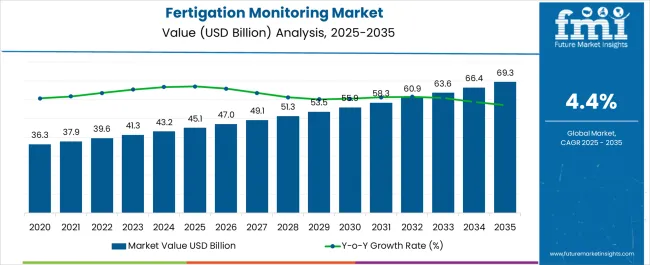
| Metric | Value |
|---|---|
| Fertigation Monitoring Market Estimated Value in (2025 E) | USD 45.1 billion |
| Fertigation Monitoring Market Forecast Value in (2035 F) | USD 69.3 billion |
| Forecast CAGR (2025 to 2035) | 4.4% |
The fertigation monitoring market is experiencing significant growth, supported by the rising demand for efficient agricultural practices that enhance crop yields while conserving water and fertilizer resources. Farmers and agribusinesses are increasingly adopting advanced fertigation systems to achieve precision in nutrient delivery and irrigation, reducing waste and improving productivity. The expansion of greenhouse farming and controlled environment agriculture is further driving demand for accurate monitoring solutions.
Technological advancements such as automation, IoT integration, and sensor-based systems are enabling real-time monitoring of soil and crop conditions, enhancing decision-making and ensuring optimal resource utilization. Growing concerns about sustainability and regulatory pressures to minimize environmental impact are also influencing adoption.
The future outlook is shaped by the integration of digital platforms, data analytics, and cloud-based services, which are expected to provide farmers with actionable insights to optimize fertigation processes As global food demand rises and pressure mounts on agricultural land, fertigation monitoring is set to become a cornerstone of modern farming practices, ensuring higher efficiency, reduced input costs, and improved sustainability.
The fertigation monitoring market is segmented by technology, analysis technique, fertigation devices, and geographic regions. By technology, fertigation monitoring market is divided into Automated and Manual. In terms of analysis technique, fertigation monitoring market is classified into Soil Testing and Plant Tissue Testing. Based on fertigation devices, fertigation monitoring market is segmented into Dosing Unit Systems, Pressure Devices, and Hydraulic Systems. Regionally, the fertigation monitoring industry is classified into North America, Latin America, Western Europe, Eastern Europe, Balkan & Baltic Countries, Russia & Belarus, Central Asia, East Asia, South Asia & Pacific, and the Middle East & Africa.
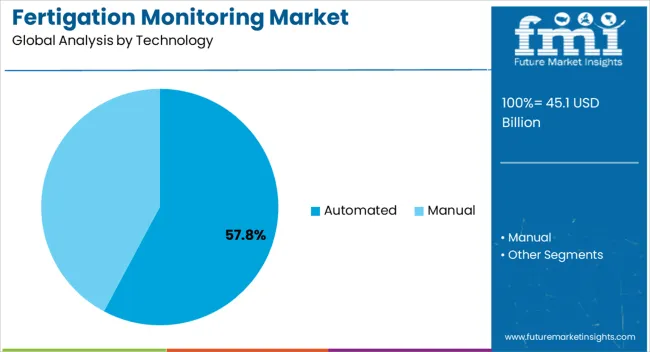
The automated technology segment is projected to account for 57.8% of the fertigation monitoring market revenue share in 2025, making it the leading technology type. Its dominance is being driven by the ability to deliver precise control over fertilizer and water application without requiring manual intervention. Automated systems are enabling farmers to achieve consistent results across large-scale operations by adjusting nutrient and water levels in real time based on sensor data.
This approach reduces human error, optimizes resource utilization, and improves crop uniformity, directly contributing to higher yields. Adoption of automated fertigation monitoring is also being supported by rising labor costs and the shortage of skilled agricultural workers, making automation a cost-effective solution.
The segment is further benefiting from integration with IoT platforms and cloud-based control systems, which allow farmers to monitor and manage operations remotely With sustainability and efficiency becoming critical drivers in modern agriculture, automated fertigation monitoring systems are expected to remain the preferred technology in both developed and emerging agricultural markets.
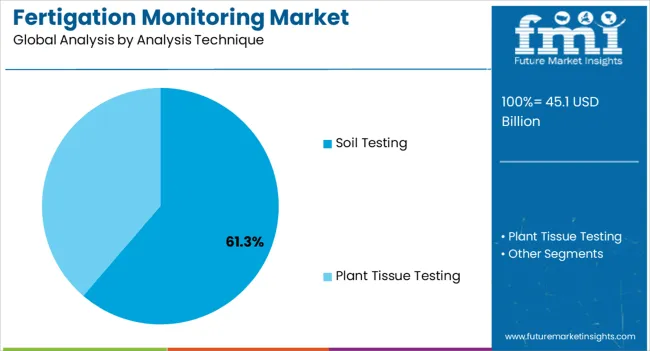
The soil testing analysis technique segment is anticipated to hold 61.3% of the fertigation monitoring market revenue share in 2025, positioning it as the leading analysis technique. Its leadership is being reinforced by the increasing recognition of soil health as a key factor in crop productivity and long-term sustainability. Soil testing provides critical insights into nutrient availability, pH balance, and moisture content, enabling farmers to optimize fertigation schedules and avoid over-application of fertilizers.
The segment is supported by growing adoption of sensor-based technologies and digital soil mapping solutions, which allow for real-time data collection and analysis. Regulatory emphasis on reducing fertilizer runoff and environmental contamination is further encouraging the use of soil testing methods to ensure compliance with standards.
Advances in portable testing kits and integration with automated fertigation devices are also making soil testing more accessible to farmers across diverse scales of operation As precision agriculture gains prominence, soil testing as an analysis technique is expected to remain central to informed decision-making and efficient resource management.
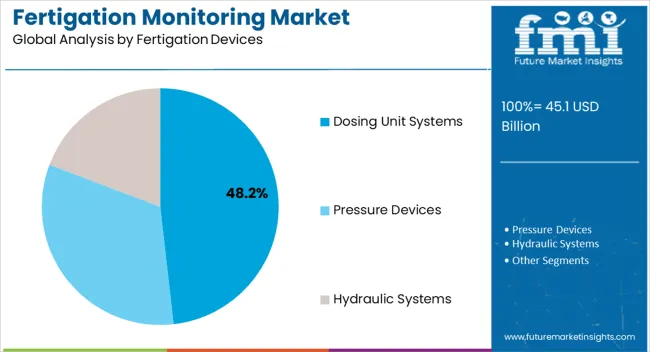
The dosing unit systems segment is expected to represent 48.2% of the fertigation monitoring market revenue share in 2025, establishing itself as the dominant category in fertigation devices. This leadership is being attributed to the ability of dosing unit systems to precisely mix and deliver nutrients in exact concentrations required by crops. The systems are capable of adjusting in real time to variations in crop stage, soil conditions, and irrigation requirements, ensuring consistent nutrient uptake and improved yield quality.
Farmers are increasingly adopting these systems due to their reliability, efficiency, and adaptability to a wide range of farming scales, from small greenhouses to large field operations. Their compatibility with automated and sensor-driven platforms further enhances operational efficiency by allowing seamless integration into broader precision agriculture systems.
The cost savings achieved through reduced fertilizer wastage and improved crop performance are key factors reinforcing adoption As agricultural practices move toward data-driven and resource-efficient models, dosing unit systems are expected to retain their leadership position as the most widely used fertigation monitoring devices.
The market grew with a CAGR of 3.2% between 2025 and 21 as growers and agricultural groups are concentrating on regulating nutrient management to boost crop productivity. By examining the soil, plants, irrigation system, etc., fertigation monitoring services are giving them options to enhance the fertigation system. Additionally, fertigation systems are being adopted by farmers and other agricultural stakeholders since they save nutrients and cut down on labor. The market for remote fertigation monitoring services is being driven by these considerations.
Manufacturers are implementing fertigation monitoring systems to improve soil nutrient concentration, improving yield and crop growth until a minimal concentration of the optimal nutrient in the root zone is achieved. Low soil nutrient concentration limits yield and plant growth.
A cost-benefit analysis of fertigation monitoring also takes into account economic factors and environmental expenses related to inadequate water management and nutrient deficiencies.
By overcoming the losses in crop and livestock output when trying to meet rising agricultural demand with current farming practices, climate change is now playing a significant role in the formulation of fertigation monitoring techniques.
Additionally, investments in and advancements in agricultural technology are raising productivity and output. Agricultural output is significantly impacted by food losses and waste, therefore reducing these would reduce the demand for production increases.
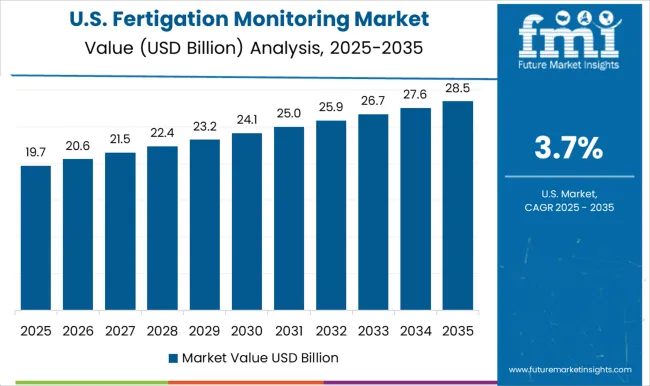
The North American market is anticipated to dominate the worldwide target market in terms of sales. The USA is the largest market for fertigation monitoring techniques, and producers are producing high-quality nutrients for a variety of agricultural uses.
Major businesses are spending an increasing amount of money to update infrastructure and facilities with the newest environmental control technology, including advanced fertigation monitoring systems.
In Asian countries, the market for fertigation monitoring systems has also expanded, and it seems very promising for future expansion. Expansion in China, Japan, and India is being encouraged by several factors, including high growth in the agriculture industry and the expanding agriculture business. It is expected that India and China will each hold the greatest market value share in South and East Asia.
According to estimates, the European fertigation monitoring industry will expand gradually. European nations adopted effective irrigation systems, technologies, and procedures to maximize water usage efficiency in response to increasing competition for scarce water resources. As a result, the market for fertigation monitoring is seeing an increase in demand.
It is anticipated that the market for fertigation monitoring systems would expand quickly during the forecast period, propelled by significant expenditures made by industry participants in response to rising consumer demand for healthier yields and ecological balances.
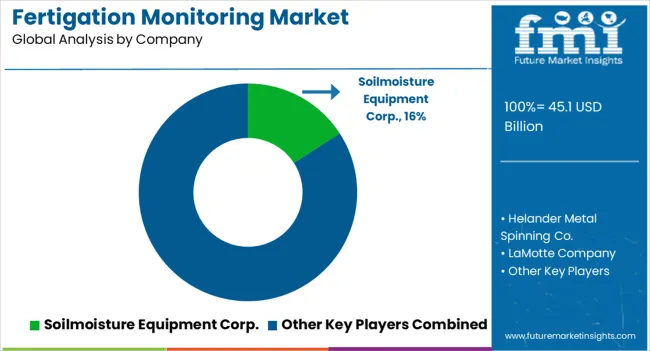
A majority of market players are concentrating on strategic alliances in the moderately consolidated competitive environment that exists in the fertigation control system market. Leading producers of fertigation control systems are currently focusing on Research and Development initiatives and the introduction of new products to keep up with the region's growing product consumption.
For Instance- The University of Cordoba announced the release of the Reutivar App, a new mobile app that will calculate and regulate the amount of water and fertilizer in irrigation systems, in June 2025.
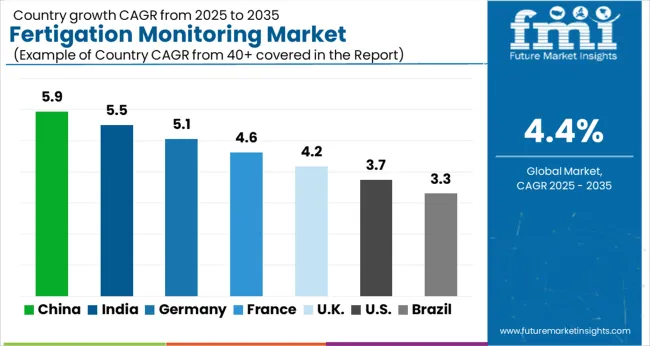
| Country | CAGR |
|---|---|
| China | 5.9% |
| India | 5.5% |
| Germany | 5.1% |
| France | 4.6% |
| UK | 4.2% |
| USA | 3.7% |
| Brazil | 3.3% |
The Fertigation Monitoring Market is expected to register a CAGR of 4.4% during the forecast period, exhibiting varied country level momentum. China leads with the highest CAGR of 5.9%, followed by India at 5.5%. Developed markets such as Germany, France, and the UK continue to expand steadily, while the USA is likely to grow at consistent rates. Brazil posts the lowest CAGR at 3.3%, yet still underscores a broadly positive trajectory for the global Fertigation Monitoring Market. In 2024, Germany held a dominant revenue in the Western Europe market and is expected to grow with a CAGR of 5.1%. The USA Fertigation Monitoring Market is estimated to be valued at USD 15.9 billion in 2025 and is anticipated to reach a valuation of USD 23.0 billion by 2035. Sales are projected to rise at a CAGR of 3.7% over the forecast period between 2025 and 2035. While Japan and South Korea markets are estimated to be valued at USD 2.1 billion and USD 1.5 billion respectively in 2025.
| Item | Value |
|---|---|
| Quantitative Units | USD 45.1 Billion |
| Technology | Automated and Manual |
| Analysis Technique | Soil Testing and Plant Tissue Testing |
| Fertigation Devices | Dosing Unit Systems, Pressure Devices, and Hydraulic Systems |
| Regions Covered | North America, Europe, Asia-Pacific, Latin America, Middle East & Africa |
| Country Covered | United States, Canada, Germany, France, United Kingdom, China, Japan, India, Brazil, South Africa |
| Key Companies Profiled | Soilmoisture Equipment Corp., Helander Metal Spinning Co., LaMotte Company, Advantech Manufacturing, Inc, Humboldt Mfg. Co, Jain Irrigation System, Netafim, Irritec, Novedades Agricolas, and Harvel |
The global fertigation monitoring market is estimated to be valued at USD 45.1 billion in 2025.
The market size for the fertigation monitoring market is projected to reach USD 69.3 billion by 2035.
The fertigation monitoring market is expected to grow at a 4.4% CAGR between 2025 and 2035.
The key product types in fertigation monitoring market are automated and manual.
In terms of analysis technique, soil testing segment to command 61.3% share in the fertigation monitoring market in 2025.






Our Research Products

The "Full Research Suite" delivers actionable market intel, deep dives on markets or technologies, so clients act faster, cut risk, and unlock growth.

The Leaderboard benchmarks and ranks top vendors, classifying them as Established Leaders, Leading Challengers, or Disruptors & Challengers.

Locates where complements amplify value and substitutes erode it, forecasting net impact by horizon

We deliver granular, decision-grade intel: market sizing, 5-year forecasts, pricing, adoption, usage, revenue, and operational KPIs—plus competitor tracking, regulation, and value chains—across 60 countries broadly.

Spot the shifts before they hit your P&L. We track inflection points, adoption curves, pricing moves, and ecosystem plays to show where demand is heading, why it is changing, and what to do next across high-growth markets and disruptive tech

Real-time reads of user behavior. We track shifting priorities, perceptions of today’s and next-gen services, and provider experience, then pace how fast tech moves from trial to adoption, blending buyer, consumer, and channel inputs with social signals (#WhySwitch, #UX).

Partner with our analyst team to build a custom report designed around your business priorities. From analysing market trends to assessing competitors or crafting bespoke datasets, we tailor insights to your needs.
Supplier Intelligence
Discovery & Profiling
Capacity & Footprint
Performance & Risk
Compliance & Governance
Commercial Readiness
Who Supplies Whom
Scorecards & Shortlists
Playbooks & Docs
Category Intelligence
Definition & Scope
Demand & Use Cases
Cost Drivers
Market Structure
Supply Chain Map
Trade & Policy
Operating Norms
Deliverables
Buyer Intelligence
Account Basics
Spend & Scope
Procurement Model
Vendor Requirements
Terms & Policies
Entry Strategy
Pain Points & Triggers
Outputs
Pricing Analysis
Benchmarks
Trends
Should-Cost
Indexation
Landed Cost
Commercial Terms
Deliverables
Brand Analysis
Positioning & Value Prop
Share & Presence
Customer Evidence
Go-to-Market
Digital & Reputation
Compliance & Trust
KPIs & Gaps
Outputs
Full Research Suite comprises of:
Market outlook & trends analysis
Interviews & case studies
Strategic recommendations
Vendor profiles & capabilities analysis
5-year forecasts
8 regions and 60+ country-level data splits
Market segment data splits
12 months of continuous data updates
DELIVERED AS:
PDF EXCEL ONLINE
Remote Fertigation Monitoring Services Market
Monitoring Tool Market Size and Share Forecast Outlook 2025 to 2035
Fertigation Control System Market Size and Share Forecast Outlook 2025 to 2035
Pet Monitoring Camera Market Size and Share Forecast Outlook 2025 to 2035
Pain Monitoring Devices Market Size and Share Forecast Outlook 2025 to 2035
Dose Monitoring Devices Market - Growth & Demand 2025 to 2035
Brain Monitoring Market Size and Share Forecast Outlook 2025 to 2035
Motor Monitoring Market Size and Share Forecast Outlook 2025 to 2035
Neuro-monitoring System Market Size and Share Forecast Outlook 2025 to 2035
Media Monitoring Tools Market Size and Share Forecast Outlook 2025 to 2035
Noise Monitoring Devices Market Size and Share Forecast Outlook 2025 to 2035
Nerve Monitoring Devices Market Insights - Growth & Forecast 2025 to 2035
Power Monitoring Market Report - Growth, Demand & Forecast 2025 to 2035
Urine Monitoring Systems Market Analysis - Size, Trends & Forecast 2025 to 2035
Brain Monitoring Systems Market is segmented by Lateral Flow Readers and Kits and Reagents from 2025 to 2035
Flare Monitoring Market
Yield Monitoring Systems Market
Driver Monitoring System Market Growth - Trends & Forecast 2025 to 2035
Tunnel Monitoring System Market Growth - Trends & Forecast 2025 to 2035
Voltage Monitoring Integrated Circuit Market Size and Share Forecast Outlook 2025 to 2035

Thank you!
You will receive an email from our Business Development Manager. Please be sure to check your SPAM/JUNK folder too.
Chat With
MaRIA